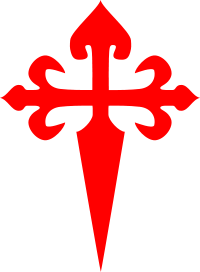Violante Sánchez of Castile
In her own right, she was Lady of Ucero, Oímbra and Vilamartín de Valdeorras, among other towns,[1] and after becoming a widow, she professed as a nun in the Order of Santiago, to which she gave all her possessions in 1327, and was a patron and commander of the Monastery of Sancti Spiritus in Salamanca.
[37] In 1325 Violante Sanchez de Castilla began to exercise patronage, despite the discontent of the Grand Masters of the Order of Santiago[38] and the nuns of the Monastery of Sancti Spiritus in Salamanca, who claimed their right to choose their own commander.
[39] At that time, the Monastery of Sancti Spiritus was one of the two most prominent hospital foundations that the Order of Santiago had in the Kingdom of León, followed by the town and castle of Castrotorafe, an uninhabited municipality located in the current province of Zamora.
[43] During the brief period in which she was patron of the Monastery of Sancti Spiritus, Violante continued to request the Pope to entrust her with the administration of other properties of the Order of Santiago that would allow her to increase her income, since the rent extracted from Sancti Spiritus was of only 300 florins per year, and that surely, as Charles García pointed out, would be insufficient for her, so she asked the pontiff to grant her the direction of the encomienda of Puerto and the administration of the properties that the Order of Santiago owned in Toro and in the Dioceses of Astorga and Zamora, who could earn her an annual income of 750 florins.
[47] A few days later, on 29 November 1325, Pope John XXII entrusted to the Archdeacon of Valderas, of the Bishopric of León, the cause of appeal that Violante, referred to in the document as the "patron" of the Monastery of Sancti Spiritus of Salamanca, had presented against Fernando Rodríguez, prior of the Convent of San Marcos of León, who had taken her to court for the thirteenth part of the income that the Salamanca monastery of Sancti Spiritus was supposed to deliver, as tithe, to said Leonese convent.
[48][e] At this time, as noted by the heraldist Faustino Menéndez Pidal de Navascués, Violante used a personal seal in whose center appeared the coat of arms of her husband, six roundels of the House of Castro, surrounded by eight castles and lions placed on the outer lobes,[7] perhaps due to her condition of being the illegitimate daughter of King Sancho IV.
[54][55][f] One year later, on 27 December 1327,[51] Violante handed over to the Order of Santiago and to its his new Grand master Vasco Rodríguez de Coronado[g] all the assets and rights she possessed, among which were included the Lordships and castles of Ucero and Vilamartín de Valdeorras, numerous cotos in Galicia, her lands in Burgos, which he inherited from her mother in Soria and Valladolid,[58] and all her other possessions in the Kingdoms of Castilla, León and Portugal, also providing that all those goods could be delivered, sold, pawned, exchanged or disposed of by the said Order,[59] since to be admitted to it, it was necessary for her to renounce all her personal assets.
[h] Historian Charles García also highlighted the fact that she didn't order masses for her soul, which contrasted, for example, with the provisions of her stepmother, Queen María de Molina,[62] who had commissioned 10,000 masses sung for her soul in her will,[63] and stressed that Violante's will allows knowing her intimate thoughts, her social relationships, and the functioning of the world of the high Castilian nobility at the time of King Sancho IV and his grandson King Alfonso XI, who reigned in Castile at that time.
[64] At the beginning of her will, Violante declared that she was "en mio sano seso e en mía sana memoria" (in my healthy brain and in my healthy memory),[65] which was an indispensable requirement to be able to be a testator, and she entrusted her soul to Jesus Christ, the Virgin Mary, and Saint Mary Magdalene and the apostle James,[66] at the time which provided that upon her grave:[67] Also, I ordered to my third parties to buy a coffin in which I ordered them to put me and in which they bury me and cover it with black tapestry with ribbons and with their folda and with the arms of Santiago placed on the tapestry over the coffin, I command that they made my buril with a stone that matches the ground and that of the stone that they put Santiago's arms on a epitaph that says like this: Here lies lady Violante, daughter of the most noble King Sancho and Maria Alfonso (lady who) was from Ucero.
[34] And on 29 January 1330, five days after having granted the will, Violante added a clause to it in which she also designated her niece Queen María de Portugal, wife of Alfonso XI, as executor, begging her to respect and enforce her last wishes.




